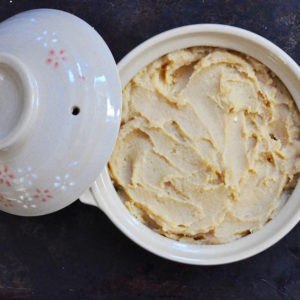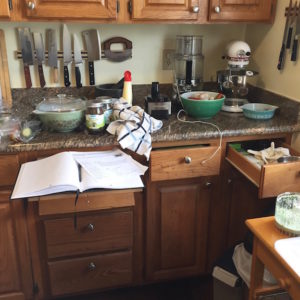Kitchen Note: Pickled Lemons. Picked Garlic. Migraines.
So, if you’re American, on American soil, chances are good you’ve come through Thanksgiving. Congratulations.
So, this migraine. There are migraines, and migraines. If you are a migraineur, you’re like, if she’s typing, it cannot be that bad. And you’re right: some migraines, it’s puke your way to the ER, where hospital staff immediately realize you are the real deal, not a drug-seeking junkie: your blood pressure is through the roof, your heart rate is galloping right alongside. You cannot give your address or date of birth. You can only vomit. And maybe sort of mewl.
This migraine, the one the IK has now, is a neuro-annoying migraine, enough to debilitate without totally crippling. Where are the IK’s glasses? Hunt high, hunt low. The search is made harder because, well, the IK cannot see. Also because the migraine is causing scotoma in both eyes: spinning, scintillating patterns famously illustrated by Hildegard of Bingen, another migraineur. Hildegard was a nun. She did not have a husband, unless you count Jesus. Jesus did not need Hildegard to help him with his daily activities. The IK’s husband is another story. He has Muscular Dystrophy. Find glasses in refrigerator. Milk on nightstand.
The inside of the IK’s nose smells dry, a smell she associates with paper bags. Not that she ever inhales paper bags. She takes her pills: Excedrin Migraine and a muscle relaxer whose effects are dubious. The muscle relaxer makes her feel woozy and spinny. Rarely does it actually alleviate the headache. So why take it? Migraine engenders desperation. Anything that might help is worth a shot, including the preventative medication the IK takes daily. Its many side effects include aphasia. The IK is a writer. She needs words. Desperation is a word. So is thesaurus.
—
If this were Roz Chast’s blog, she would ask if we could talk about something more pleasant. It’s not Ms. Chast’s blog, but we can. First, the IK has to take more Excedrin.
Excedrin taken.
So, pickled lemons. These have been on my “to make” list forever. Anyone who loves to cook has such a list, be it written, virtual, a mixture thereof. “To make” lists, or more accurately, “to cook”, were once written affairs, collections of clippings and written notes, cards or scraps of paper. I don’t know what other people do, but I still rely on paper, using cookbooks, printing off blogs, or writing things down. The blog always begins in a notebook. Some of it lives in my head, as the memory of this photograph did, from Diana Henry’s first book, Crazy Water, Pickled Lemons.
The pickled lemons of the title appear on the inside front cover, and what’s striking about them is the way they’re sliced: crosswise rather than quartered. The resulting jar of lemons looks like something you’d buy in the San Francisco Ferry Plaza Terminal Market, wrapped up in a repurposed apothecary jar and costing more than a Perigourdian truffle.
Happily, the IK’s pickled lemons are a locavore’s dream, hailing all the way from her yard. Further, these are an especially hardy cross-breed of Eureka, resistant even to the IK’s renowned black thumb.

Henry is vague on amounts here, in fact giving none at all. And because I used lemons from my yard, it’s hard to be specific. But all you need is sea salt, paprika, organic lemons, olive oil, and enough sterilized jars, so it’s up to you how much or how little you want to make. I ended up with one half-pint jar–that’s 8 ounces–and a larger jar holding one quart.
Scrub your lemons really well, then slice them thinly, crosswise. If you have difficulty slicing as you get toward the end of a lemon, slice the very end of the lemon off to make a flat base, then slice top to bottom. These smaller pieces may be fitted down into the gaps in your jar(s).
Place the lemons in a fine mesh strainer that you’ve set into a bowl. Cover the lemons with sea salt. I use an inexpensive organic Korean sea salt. It’s very coarsely grained, as you see in the photo. Cover the bowl lightly–I used foil–and leave overnight.
The next day your lemons may not look all that different.

What liquid you find in the bowl will be extremely salty and lemony. If you can figure out a use for it, more power to you.
Sterilize your jars hot soapy water and dry them either in the dishwasher or a low oven. Then, with clean, clean, clean hands, layer in the lemon, a sprinkle of paprika, then lemon, repeating until the jar is full. Don’t rinse the salt off the lemons. If you have sensitive skin or cuts of any sort, you may want to wear clean gloves, because lemon juice and salt can sting or smart. Then again, it’s sure to sterilize just about anything.
Top off with olive oil and seal for at least three weeks, longer if you can stand it. Henry says these lemons may be used with chicken, pork, lamb chops, wherever you would use salted preserved lemons.
I filled gaps with smaller pieces of lemon, and added the occasional sprinkling of paprika picante.

I would say this makes a great gift, but it really depends on the recipient. Some people have no idea about handmade food gifts. These puzzled recipients just toss your hard work. Share only with the deserving, who you know will appreciate the contents of that jar. Otherwise, eat it yourself!
Finally, pickled garlic, from the marvelous All Under Heaven, by Carolyn Phillips. This is going to get its own blog post. Stay tuned.





